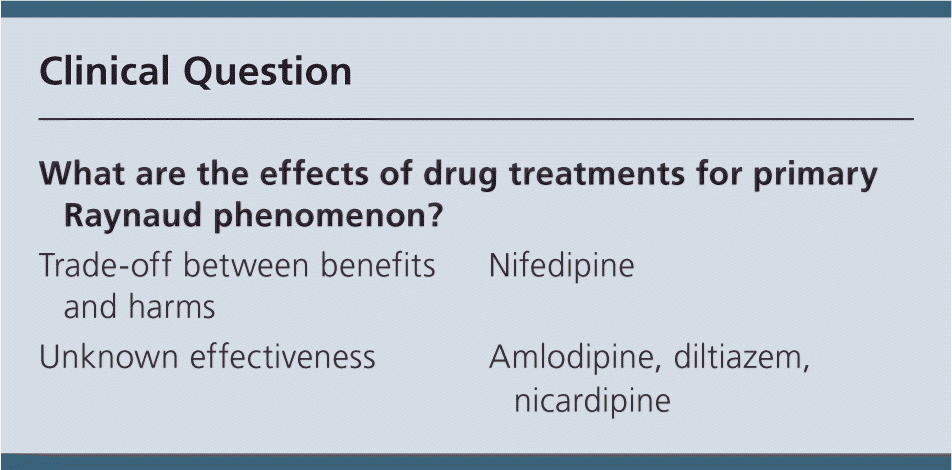
Am Fam Physician. 2014;90(6):403-404
Author disclosure: Janet Elizabeth Pope declares that she has no competing interests.
Raynaud phenomenon is an episodic, reversible vasospasm of the peripheral arteries, usually digital. It causes pallor followed by cyanosis and/or redness, often with pain and, at times, paresthesia. On rare occasions, it can lead to ulceration of the fingers and toes and, in some cases, of the ears or nose. This review focuses on primary (idiopathic) Raynaud phenomenon occurring in the absence of an underlying disease.
Prevalence, which varies by sex and country, is around 3% to 5% in most population studies, 80% to 90% of which is primary Raynaud phenomenon; prevalence is slightly higher in women than in men.
Attacks may last from several minutes to a few hours, and persons with initial long-term idiopathic Raynaud phenomenon can later go on to display features of underlying disorders such as systemic sclerosis.
Nifedipine seems to reduce the frequency and severity of Raynaud attacks, although it is associated with high rates of adverse effects such as tachycardia, headache, and flushing.
We found no evidence of sufficient quality to judge the effectiveness of amlodipine or diltiazem in treating primary Raynaud phenomenon.
Nicardipine may successfully treat primary Raynaud phenomenon, but we found no studies large enough to draw firm conclusions.

| What are the effects of drug treatments for primary Raynaud phenomenon? | |
| Trade-off between benefits and harms | Nifedipine |
| Unknown effectiveness | Amlodipine, diltiazem, nicardipine |
Definition
Primary or idiopathic Raynaud phenomenon (Raynaud disease) occurs without an underlying disease. Secondary Raynaud phenomenon (Raynaud syndrome) occurs in association with an underlying disease, usually connective tissue disorders, such as systemic sclerosis (scleroderma), systemic lupus erythematosus, rheumatoid arthritis, Sjögren syndrome, or polymyositis.
The diagnosis of Raynaud phenomenon is by a history of clearly demarcated pallor of one or more digits, followed by at least one other color change (cyanosis, erythema), which is usually precipitated by cold. A history, physical examination, and laboratory results can help rule out secondary Raynaud phenomenon. The patients should be evaluated for symptoms or signs of connective tissue disease. Laboratory testing may include full blood count, erythrocyte sedimentation rate, and antinuclear antibodies with pattern if connective tissue diseases are suspected. Magnification of the nail beds to observe abnormal capillaries is also important to rule out Raynaud phenomenon associated with connective tissue diseases.
Incidence and Prevalence
The prevalence of primary Raynaud phenomenon varies by sex, country, and work-place exposure to vibration. One large U.S. cohort study of 4,182 persons found symptoms in 9.6% of women and 8.1% of men, of whom 81% had primary Raynaud phenomenon. Smaller cohort studies in Spain have estimated the prevalence of Raynaud phenomenon to be 3.7% to 4.0%, of which 90% is primary Raynaud phenomenon. One study in Japan of 332 men and 731 women found symptoms of primary Raynaud phenomenon in 3.4% of women and 3.0% of men. A study of 12,907 persons in the United Kingdom reported that 4.6% of persons had demarcated finger blanching with cold exposure.
Etiology and Risk Factors
The cause of primary Raynaud phenomenon is unknown. There is evidence for genetic predisposition, usually in persons younger than 40 years with early-onset Raynaud phenomenon. One prospective observational study of 424 persons with Raynaud phenomenon found that 73% of persons first developed symptoms before 40 years of age. Women are at higher risk than men (odds ratio = 3.0; 95% confidence interval, 1.2 to 7.8, in one U.S. case-control study of 235 persons). The other known risk factor is occupational exposure to vibration from tools (symptoms developed in about 8% with exposure vs. 2.7% with no exposure in two cohorts from Japan). Persons who are obese may be at lower risk. Exposure to cold or heightened emotion can worsen symptoms.
Prognosis
Attacks may last from several minutes to a few hours. One systematic review found that 13% of persons with long-term Raynaud phenomenon later manifested an underlying disorder, such as systemic sclerosis. [corrected] In a large cohort of patients with Raynaud phenomenon and no known connective tissue disease who were seen in a specialist rheumatology clinic, 13% developed systemic sclerosis over time. Those who progressed to systemic sclerosis had abnormal dilated capillaries at the nail folds and systemic sclerosis–specific antibodies.
Complications of Raynaud phenomenon, such as digital ulceration or severe ischemia, may indicate a secondary cause. In general, complications of primary Raynaud phenomenon do not occur. However, some patients without a known underlying cause have complications. They may manifest over time as secondary Raynaud phenomenon that could not be diagnosed earlier. For instance, a small proportion (1% to 2%) of persons with primary Raynaud phenomenon may transition to secondary Raynaud phenomenon annually. Those who develop secondary Raynaud phenomenon are likely the patients who have complications of Raynaud phenomenon.
